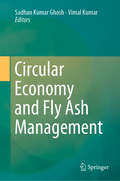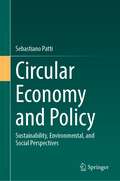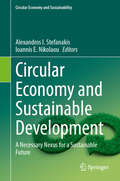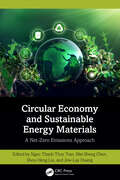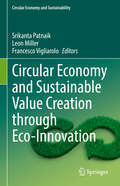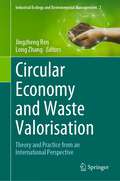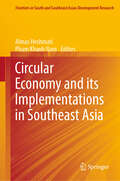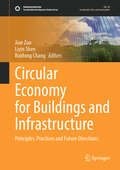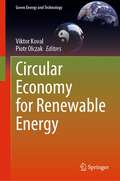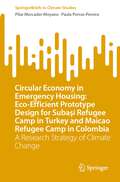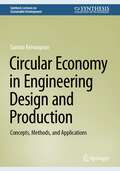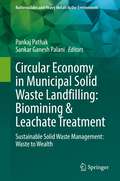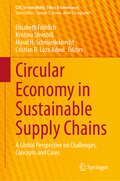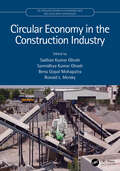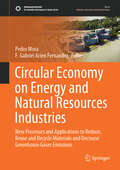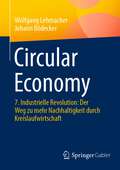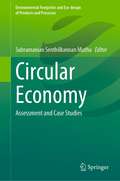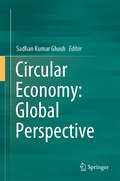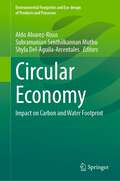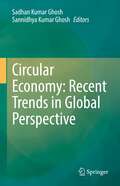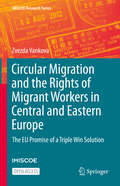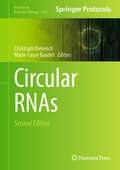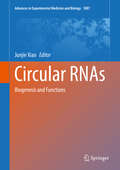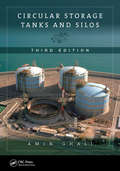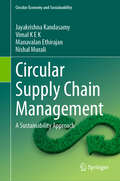- Table View
- List View
Circular Economy and Fly Ash Management
by Vimal Kumar Sadhan Kumar GhoshThis book presents a number of innovative uses of fly ash. Fly ash is a fine powder that is a byproduct of burning pulverized coal in thermal power plants. It is a pozzolan – a substance containing aluminous and siliceous material that when mixed with lime and water forms a compound similar to Portland cement. Though fly ash was a problem in terms of its disposal, it now has a variety of uses, such as a prime material in blocks, bricks, and PCC paving, and further applications are being investigated. As such, the recovery and reuse of fly ash wastes plays an important role in the implementation of the circular economy concept. Featuring selected, high-quality research papers presented at IconSWM 2018, the book provides valuable insights for the recycling industries, power plants, researchers, and governments.
Circular Economy and Policy: Sustainability, Environmental, and Social Perspectives
by Sebastiano PattiThis book uses economic and policy approaches to highlight sustainability, environmental, and social aspects of the circular economy. It emphasizes the circular economy within the market’s perspective, including the links between consumption and sustainability, and how balances between profitability and environmental sustainability can be attained. The author also uses a life cycle assessment approach to improve and evaluate circular economy strategies to help determine the environmental, social, and economic consequences of a product. The chapters illustrate circular business models and sustainability consumption behaviour in the public sector, while also measuring eco-efficiency and sustainability impacts. The book will useful for students and researchers in environmental and sustainability economics, as well as businesses and government organizations adapting policies to develop environmentally sustainable economic practices.
Circular Economy and Sustainable Development: A Necessary Nexus for a Sustainable Future (Circular Economy and Sustainability)
by Alexandros I. Stefanakis Ioannis E. NikolaouThis book will highlight the role of CE in the sustainability field as it is expressed in the various fields and disciplines and its contribution to building a sustainable society by providing a better understanding of the relevant social and cultural structures and the need for cross-disciplinary knowledge and diverse skills. Such an integrated approach which combines the concept of sustainability in the engineering field to create a CE, has not yet been presented in detail in the published literature, and there are only scattered studies covering only small parts of this holistic approach. Hence, this book will represent a single reference that will provide summarized information and state-of-the-art knowledge on this topic of the future. The book will include chapters showcasing/investigating the relation between circular economy principles and their realization in different engineering fields. This includes theoretical justification, research studies and full-scale case studies. The approach focuses on two distinct levels: macro and micro, on both production and consumption sides.
Circular Economy and Sustainable Energy Materials: A Net-Zero Emissions Approach
by Ngoc Thanh Thuy Tran Jow-Lay Huang Wei-Sheng Chen Shou-Heng LiuAchieving carbon neutrality is crucial for creating a sustainable and resilient future worldwide. The circular economy framework focuses on reducing waste, optimizing resource use, and promoting regenerative practices, thus curbing carbon footprints. Concurrently, sustainable energy techniques, such as harnessing renewable sources, enhancing energy storage, and boosting energy efficiency, contribute to the reduction of greenhouse gas emissions. With a unique emphasis on net-zero emission approaches, this book delves into circular economy principles and sustainable energy materials, offering a comprehensive perspective on climate change challenges. Covers fundamental circular economy principles, from carbon capture to advancements in biomass and hydrogen energy Explores recycling techniques for essential energy materials, including batteries, solar cells, and fuel cells Provides detailed coverage of technologies, processes, and challenges related to achieving sustainability in the energy sector Bridges theory and practical applications Offering a roadmap toward a carbon neutral and net-zero emission future, this book serves as a valuable resource for advanced students, researchers, engineers, and policymakers worldwide seeking solutions to climate change and sustainable development.
Circular Economy and Sustainable Value Creation through Eco-Innovation (Circular Economy and Sustainability)
by Srikanta Patnaik Francesco Vigliarolo Leon MillerCircular economy and sustainable value creation through eco-innovation are interconnected concepts that revolve around creating a more sustainable and environmentally friendly approach to economic growth and business development. In a world confronted by pressing environmental challenges, the need for sustainable economic practices has never been more urgent. The traditional linear economic model, characterized by the "take-make-dispose" approach, has led to resource depletion, environmental degradation, and social inequalities. In response to these challenges, the concepts of circular economy and eco-innovation have emerged as powerful frameworks for reshaping our economic systems to prioritize sustainability. The circular economy represents a paradigm shift from the linear economic model that has dominated for centuries. Instead of viewing resources as finite and disposable, the circular economy embraces the idea that resources can be kept in circulation for as long as possible, thereby minimizing waste and environmental impact. At the core of the circular economy is the efficient use of resources. This entails reducing resource consumption, reusing products and materials, and recycling to extend the life of resources. Products are designed with durability and ease of repair in mind, ensuring they have a longer lifespan and can be easily maintained. Circular practices aim to restore natural systems and reduce harm to the environment, whether through reforestation, soil regeneration, or sustainable agriculture.
Circular Economy and Waste Valorisation: Theory and Practice from an International Perspective (Industrial Ecology and Environmental Management #2)
by Jingzheng Ren Long ZhangThe authors and editors of this volume state that with the intensive growth of global industrialization and urbanization, the consumption of various resources and materials, such as energy, minerals, and even water, is increasing at an amazing speed, which poses great pressure on material resources. In addition, the massive utilization of materials has led to low efficiency, resulting in great wastes of resources as well as serious environmental pollutions and degradation, which has severely hindered the sustainable development of economy and society. In order to transit to sustainable development, it is necessary to improved resource efficiency, and circular economy and waste valorization are the best alternative ways for achieving this goal. This book aims to provide an in-depth description of circular economy and waste valorization, make assessments for circular economy and waste valorization in different regions and countries and determine the technological pathways and roadmap for achieving circular economy and waste valorization. More specifically: (1) Conceptions and Theories: Concepts and definitions of circular economy and waste valorization and their nexus and contributions to sustainable development. (2) Policy and Practice: Measurement and assessment of performance or sustainability for implementing circular economy and waste valorization. (3) Pathways and Prospects: Identification and prioritization of the barriers, strategies, technologies, and pathways for achieving circular economy and waste valorization. The book systematically and comprehensively introduces the definitions, concepts, framework and nexus of circular economy and waste valorization, analyzes and measures their performance and sustainability and provides the methods for investigating and prioritizing the barriers and strategies and determining the pathways and roadmap for their development.
Circular Economy and its Implementations in Southeast Asia (Frontiers in South and Southeast Asian Development Research)
by Almas Heshmati Pham Khanh NamThis edited volume explores the implementation of the circular economy (CE) in Southeast Asia, a densely populated region with a significant share of global production. It examines the region’s transition from a linear to a circular economy, providing a comprehensive overview of CE applications across various parts of Southeast Asia. The book offers unique and empirical insights into the approaches, methods, laws, and policies that facilitate the transformation to a CE. It highlights how recent research, trends, and attitudes can be practically oriented towards sustainable development. By linking environmental theory with practice, the book provides practitioners with a deeper understanding of CE and the challenges involved in its implementation. A timely and practical guide, this book is essential for sustainability researchers and policymakers in Asia striving to achieve CE and sustainable development goals. It presents an up-to-date picture of Southeast Asia’s fast-growing economy, showcasing the region’s heavy investment in development infrastructure and cooperative efforts towards environmental sustainability. Authored by professionals with deep insights into the region’s economy and development potential, the chapters offer empirical, research-based perspectives on recent economic trends. This volume fills a crucial knowledge gap regarding Southeast Asian economies, their environmental conditions, and development potential. It also guides emerging economies like Vietnam in sustainable development, helping them avoid the pitfalls of environmental missteps in production, resource utilization, and consumption.
Circular Economy for Buildings and Infrastructure: Principles, Practices and Future Directions (Sustainable Development Goals Series)
by Liyin Shen Jian Zuo Ruidong ChangThis edited volume covers theoretical and practical aspects of circular economy in building development, offering chapters dealing with topics such as material design, affordability of housing development, waste management and recycling, smart metering, and more. A particular focus is placed on various stakeholders’ points of view. The book's chapters are co-developed and contributed by multidisciplinary teams including both academics and industry practitioners. The case study-oriented approach taken here helps to facilitate the reader's understanding of how building sustainability can be achieved in the context of circular economy. The building industry has significant environmental, social and economic impacts. As one of the biggest energy consumers and carbon emitters, building sustainability has attracted wide attention globally. Building projects and their associated activities consume a large amount of energy, natural resources and water while producing a large proportion of wastes throughout their lifecycles. The traditional linear approach of “make, use and dispose” has been heavily criticized, whilst the circular approach has gained momentum. Indeed, circular economy has emerged as one of key principles to manage sustainability related issues by means of focusing on the circularity of resources as well as the cost implications.
Circular Economy for Renewable Energy (Green Energy and Technology)
by Viktor Koval Piotr OlczakThis book explores the role of renewable energy sources in driving sustainable development, with a focus on their circular use in achieving environmental efficiency and an energy balance. The authors highlights the significance of renewable energy in reducing costs for producers and consumers while also ensuring the production of clean energy that can be integrated seamlessly into the national power grid without compromising reliability or energy security.Readers are introduced to the circular economy model and its importance in the context of renewable energy. The book sheds light on the challenges associated with transitioning to alternative energy systems, particularly in cases where not all resources can be fully circulated. Through the research presented in this book, stakeholders will gain insights into how the sustainable renewable energy supply chain can be adapted within the circular economy. This will have a synergistic effect in reducing carbon emissions, and also aid in the production of renewable energy equipment.
Circular Economy in Emergency Housing: A Research Strategy of Climate Change (SpringerBriefs in Climate Studies)
by Pilar Mercader-Moyano Paula Porras-PereiraIn recent years, there has been an upsurge in the number of forced displacements due to natural disasters, armed conflicts, and pandemics, which has favoured an increase in the number of temporary accommodations. Although the provision of shelter after an emergency situation is one of the priorities of humanitarian aid, the reality is that the conditions in which people live in a situation of forced displacement are absolutely precarious and overcrowded. Nowadays, this type of housing tends to have a short lifespan, deepening the environmental impact and the generation of waste. Likewise, added to this great problem is the linear economic system implemented worldwide, which also causes a high rate of waste.This investigation develops an eco-efficient design protocol that determines the basic premises in any emergency situation, therefore avoiding the precarious nature to which those in forced displacement are exposed. Moreover, the research investigates different constructive solutions that can respond to situations of natural catastrophes or humanitarian disasters where emergency housing is needed as well as the possible alternatives from the point of view of circular economy. Eco-efficient and environmentally correct solutions are sought, which can be adaptable to the different scenarios where emergency housing may be needed, thus creating a rapid, easy, functional, and environmentally correct architecture, adaptable to these types of situations. The study shows that the factors that characterize emergency architecture can be an example of where the issues around the sustainability factor are applied in a practical way. The main objectives of this study are to develop an eco-efficient design protocol which determines the basic premises in any emergency situation and to find eco-efficient and environmentally correct solutions, adaptable to different scenarios, which have similar climatic characteristics, and where emergency housing may be needed, thus creating a type of ephemeral architecture but sensitive to the user to whom it is intended and in accordance with the optimal conditions of habitability.
Circular Economy in Engineering Design and Production: Concepts, Methods, and Applications (Synthesis Lectures on Sustainable Development)
by Samira KeivanpourThis concise text provides the concepts, methods, and application examples for integrating sustainability into engineering design and production. It discusses the role of sustainability in the value creation processes of various enterprises and different tools and methods for systematic incorporation of social and environmental aspects into the product's life cycle. The following topics are covered: sustainable development in engineering systems and the life cycle concept, norms and standards in the sustainable development and integration of socio-economic assessment into technical valuation, production systems, management of the production systems based on circular economy principles, ecodesign practices, and value creation and innovative design in the circular economy. Provides a concise guide for engineering students for applying circular economy practicesPresents examples and short case studies for understanding the methods and toolsFacilitates understanding and application of the life cycle perspective in product manufacturing and green engineering
Circular Economy in Municipal Solid Waste Landfilling: Sustainable Solid Waste Management: Waste to Wealth (Radionuclides and Heavy Metals in the Environment)
by Pankaj Pathak Sankar Ganesh PalaniThis book will serve as a ready reckoner of contemporary information regarding municipal solid waste landfill biomining, treatment of landfill leachate and heavy metals in a single platform. The academicians, researchers, and students at master’s and doctoral levels will be able to understand the current trends in municipal solid waste landfill operations, which will help in augmenting their research. Construction of new landfills requires huge monetary investments, which can be avoided if old landfills were bio-mined for resources and the space can be re-used as new landfills. Landfill leachate is a hazardous waste which needs proper treatment that could generate value-added products such as clean energy and biofertilizers. In this book, each chapter would provide the background, methodology, and relevant calculations for sustaining landfill operations. Also, the case studies based on best practices in municipal solid waste landfilling are discussed in this book.
Circular Economy in Sustainable Supply Chains: A Global Perspective on Challenges, Concepts and Cases (CSR, Sustainability, Ethics & Governance)
by Elisabeth Fröhlich Kristina Steinbiß Maud H. Schmiedeknecht Cristian R. Loza AdauiCircularity is one of the most promising innovative business models for tackling the challenges posed by climate protection, resource conservation and biodiversity conservation. Circularity requires changed business structures; therefore, it is necessary to adapt existing approaches and reconcile economic and ecological interests. By focusing on the importance of horizontal integration and cross-company cooperation, this book offers valuable insights to help companies generate cross-industry synergy and symbiosis effects and secure competitive advantages along sustainable supply chains. The emphasis is on an expanded understanding of the various R principles, and on theoretical and practical application examples that help to prepare corporate business models for the ecological and social challenges of global supply chains. Given its scope, the book represents an indispensable guide for companies worldwide that want to contribute to sustainable development by adopting circular business models. It analyses the drivers and challenges of implementing these models and presents concepts and insights from pioneering companies in the circular economy, providing a global perspective for managers and researchers alike.
Circular Economy in the Construction Industry (The Circular Economy in Sustainable Solid and Liquid Waste Management)
by Sadhan Kumar Ghosh Sannidhya Kumar Ghosh Benu Gopal Mohapatra Ronald L. MerskyCircular Economy in the Construction Industry is an invaluable resource for researchers, policymakers, implementers and PhD and Masters-level students in universities analyzing the present status of Construction and Demolition Wastes (C&DW) management, materials development utilizing slag, fly ash, HDPE fibre, geo-wastes, and other wastes, green concrete, soil stabilization, resource circulation in construction sectors, success in experimentation & commercial production, future needs, and future research areas. While huge C&DW is wasted by dumping, there is potential of recycling preventing greenhouse gas (GHG) emissions and environmental pollution as well as creating business opportunities. Circularity of resources in the construction industry can contribute to a more secure, sustainable, and economically sound future through proper policy instruments, management systems, and recycling by selecting the following: Supply chain sustainability and collection of C&D Wastes, Appropriate separation and recycling technology, Enforcement of policy instruments, Productivity, quality control of recycled products and intended end use, Economic feasibility as business case, commercialization, generating employment. This book addresses most of the above issues in a lucid manner by experts in the field from different countries, which are helpful for the related stakeholders, edited by experts in the field.
Circular Economy on Energy and Natural Resources Industries: New Processes and Applications to Reduce, Reuse and Recycle Materials and Decrease Greenhouse Gases Emissions (Sustainable Development Goals Series)
by Pedro Mora F. Gabriel Acien FernandezThis book masterfully bridges the gap between science and industry, offering readers invaluable insights into the technological advancements shaping our world. Amidst a profound industrial transformation aimed at minimizing environmental impact, this work highlights the pivotal role of reducing energy consumption and material waste. It aligns closely with the United Nations Sustainable Development Goals, encapsulating the global ambition for the coming years. The narrative delves into myriad examples of industrial evolution, showcasing how various sectors, especially energy (including electricity and oil & gas) and natural resource exploitation, are revolutionizing their processes to lessen their environmental footprint. Furthermore, each chapter of the book equips readers with the knowledge to spearhead innovative solutions tailored to these evolving processes, making it an essential resource for anyone committed to driving sustainable industrial advancements.
Circular Economy: 7. Industrielle Revolution: Der Weg zu mehr Nachhaltigkeit durch Kreislaufwirtschaft
by Wolfgang Lehmacher Johann BödeckerWenn wir unseren Lebensstandard und Lebensraum erhalten wollen, müssen wir radikal umdenken und unsere Wirtschaft neu gestalten. Gefragt ist eine zirkuläre, umwelt-zentrierte Wirtschaft. Nur wenn es gelingt, bei unserem Handeln auf den Gesamtkomplex Leben Rücksicht zu nehmen, werden wir unseren Planeten erhalten können – und damit unseren Wohlstand und unsere Lebensqualität langfristig sichern.Das Buch beschreibt sehr anschaulich, was Circular Economy für Unternehmen und die gesamte Wirtschaft bedeutet. Zahlreiche Beispiele und strategische Umsetzungsideen bieten einen Einblick in die erfolgreiche Realisierung.
Circular Economy: Assessment and Case Studies (Environmental Footprints and Eco-design of Products and Processes)
by Subramanian Senthilkannan MuthuThis book highlights the notion of Circular Economy under the umbrella of Sustainability because of the widespread momentum it is gaining. Today the whole world is certainly in emergent need of an alternative system to traditional economy which is linear, i.e. make, use and dispose to get rid-off the waste and very important to ensure continuous use of resources, which is possible by the advent of circular economy. A circular economy aims to utilize the resources in use for as long as possible, extract the maximum value from them during use, then recover and regenerate products and materials at the end of each service life vis-à-vis traditional linear model. This book discusses circular economy in terms of assessment with various case studies.
Circular Economy: Global Perspective
by Sadhan Kumar GhoshA circular economy is an alternative to a traditional linear economy (make, use, dispose) in which we keep resources in use for as long as possible, extract the maximum value from them whilst in use, then recover and regenerate products and materials at the end of each service life. Circular economy (CE) is important towards sustainable development, resources circulation and conservation, involving closing of material loops and cascading used resources, to prevent waste occurrence, and transforming the resulting residual streams into new (secondary) resources. Strategies and legislative framework for waste management are important steps for development of a more CE where resource efficiency becomes the key driver for both economic growth and environmental protections. A few countries achieved good results implementing CE as a replacement of the linear economy. Resource managers and planners should thoroughly identify factors to implement CE for societal benefits. This book presents how resource consumption is minimized with rational use based on 3Rs, legislative framework and government supports towards implementing CE initiatives, example of best practices, future plans and targets in different countries those are helpful for researchers, planners and implementers.
Circular Economy: Impact on Carbon and Water Footprint (Environmental Footprints and Eco-design of Products and Processes)
by Subramanian Senthilkannan Muthu Aldo Alvarez-Risco Shyla Del-Aguila-ArcentalesThis book highlights ways to evaluate circular economy using global standard and footprints the way global firms are using to ensure the measurement of the impact. It presents various case studies from different sectors with the efforts made to contribute to circular economy and at the same time its contribution to minimize carbon and water footprints.
Circular Economy: Recent Trends in Global Perspective
by Sadhan Kumar Ghosh Sannidhya Kumar GhoshThis book presents the advantages of the circular economy as a powerful - and inevitable - model for tackling the current challenges against shrinking resources and establishing the resource efficient economy. The experienced contributors present the status and strategies of circular economy implementation in several countries with hands on experience to protect the environment while promoting the circular economy through legislative requirements, best practices adopted and popularizing the idea of circulation of resources amongst the researchers & academia, policy makers, industry, and the general public at large. The book advocates model that consists of designing products and processes with a view to endlessly recycling them evolving a greater scope of sustainable development.
Circular Migration and the Rights of Migrant Workers in Central and Eastern Europe: The EU Promise of a Triple Win Solution (IMISCOE Research Series)
by Zvezda VankovaBy adopting a rights-based approach, this open access book sheds light on the different legal and policy instruments that have been adopted to implement circular migration policies in the EU and their consequences for the rights of migrant workers. It contributes to the understanding of the meaning of this concept in general, in the EU, as well as more specifically with regard to its Eastern neighbourhood. The book provides a comprehensive overview of the formation and implementation of the EU’s circular migration approach that has developed through both EU and national instruments on the basis of comparative case study analysis of Bulgaria and Poland’s migration law and policy. Furthermore, by applying legal empirical research methods, it draws conclusions about the policy outcomes from the implementation of the various migration instruments falling under the circular migration umbrella and shows the consequences for the rights of migrant workers as a result of the application of different policy options.Along with its value to an academic audience, the book can be used by policy makers at the EU, international and national level as well as international organisations and NGOs working in the field of migration law and policy.
Circular RNAs (Methods in Molecular Biology #2765)
by Christoph Dieterich Marie-Laure BaudetThis second edition details new and updated methods on circular RNA. Chapter guide readers through circular RNA purification, in silico characterization, circRNA detection, sequence validation, quantification , techniques related to gain- and loss-of-function approaches, circular RNA synthesis, split ligation, engineering, nanoparticle packaging, RNA modifications on circular RNA biogenesis, RNA translation potential, and vaccines based on circular RNAs. Written in the highly successful Methods in Molecular Biology series format, chapters include introductions to their respective topics, lists of the necessary materials and reagents, step-by-step, readily reproducible laboratory protocols, and key tips on troubleshooting and avoiding known pitfalls. Authoritative and cutting-edge, Circular RNAs, Second Edition aims to ensure successful results in the further study of this vital field.
Circular RNAs: Biogenesis And Functions (Advances in Experimental Medicine and Biology #1087)
by Junjie XiaoThis book provides an essential overview of the rapidly advancing field of circular RNAs – newly discovered RNAs that are generated by back-splicing precursor mRNA and perform regulatory functions in many biological processes. Although many aspects of circular RNAs’ biology and mechanisms of gene regulation remain unclear, they have been found to be abundant, evolutionally conserved, and stable in cells; further, they have numerous potential functions. The book consists of eight parts:1) An overview of circular RNAs, 2) Bioinformatics for circular RNAs, 3) Biogenesis of circular RNAs, 4) Molecular mechanisms and gene regulation of circular RNAs, 5) Circular RNAs as potential disease biomarkers, 6) Circular RNAs and human diseases, 7) Circular RNAs in Plants and in Archaea, and 8) Future prospects. Given its focus, the book will be especially useful for researchers and students in the fields of biochemistry, molecular biology, cell biology, and medicine.
Circular Storage Tanks and Silos
by Amin GhaliThis book presents practical methods for the analysis and design of circular concrete tanks. The methods can also be used for silos, pipes, or any circular shells subjected to arbitrary axially symmetrical loading, and also deal with the more general problem of beam on elastic foundation. The book includes a new chapter on the design of construction of circular tanks, comes with new easy-to-use computer programs, and provides design examples that include post-tensioned concrete walls, footings, floors and roofs, and liquid-tight connections between these components.
Circular Supply Chain Management: A Sustainability Approach (Circular Economy and Sustainability)
by Jayakrishna Kandasamy Vimal K E K Manavalan Ethirajan Nishal MuraliThis book provides fundamental knowledge of theories on the circular economy and circular supply chain management. It also discusses theories that have been developed or adopted in circular economy research. Traditional supply chains organizations have felt the importance of transforming their activities to become more circular. This book provides insights into the need for adopting circular supply chain practices and the circular business models they can adopt. Barriers that supply chain organizations will encounter in their efforts to expediate the transformation, and the drivers that they will need to achieve these goals, are elaborated in the book. The key factors that help in the decision-making process and modalities involved in modelling the circular chains are also discussed. These will be of great value to managers and other stakeholders. Additionally, the role of I4.0 technologies in future supply circular chains is elucidated. This book also offers solutions to supply chain organizations for achieving the sustainable development goals. Case studies and illustrations are provided in each chapter for easy understanding of theory to practice.
